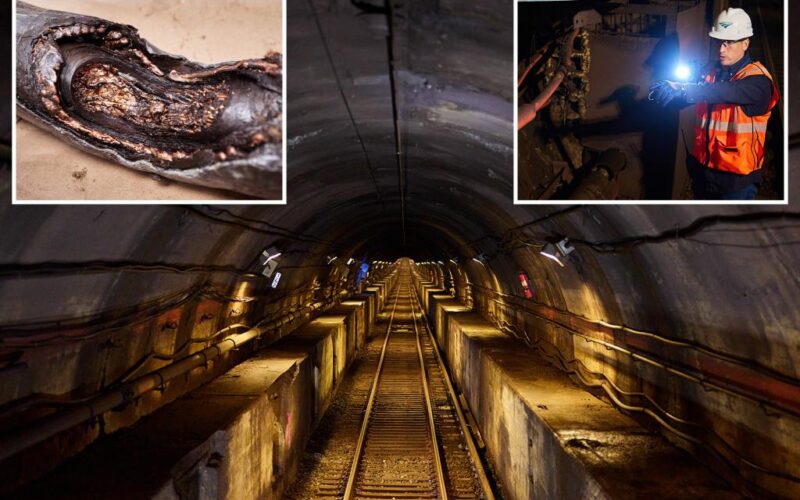Ninety feet below the East River, Amtrak’s 110 year-old train tunnels are slowly filling with salty water dripping on high-voltage cables as steel is nearly corroded to dust.
Above ground, heads of Amtrak and the Metropolitan Transit Agency are publicly sparring about who should take the blame for the millions of riders about to suffer train delays starting May 23 when one of the tracks in the tunnel is closed for much-needed repairs.
Liam McQuat, vice president of engineering services at Amtrak, said there’s no alternatives to the company’s repair plan that would squeeze another 100 years out of the East River Tunnel with “minimal intervention.”
“This has been 12 years in the making, and there’s been an awful lot of analysis ongoing over that 12 years to develop a solution,” McQuat said.
Amtrak engineers have insisted the MTA has been actively working on Amtrak’s much-maligned $1.6 billion service plan behind-the-scenes — even approving the plan in October 2023. But MTA heads have continued to publicly distance themselves from the impending delays.
“It’s Amtrak’s operation. It’s their decision to make. It’s their responsibility,” Long Island Rail Road president Rob Free said at a press conference Thursday.
“We were forced to make this decision,” Free said.
Amtrak engineers took reporters on an overnight tour into one of the corroded tunnels in the overnight hours Wednesday into Thursday to prove their point that the repairs cannot be completed on nights and weekends as Gov. Kathy Hochul, Mayor Eric Adams and MTA board members have all publicly suggested in recent weeks.
That would only give workers three hours per night to work on the dilapidated tunnels, McQuat said.
Instead, Amtrak is insisting on a full shutdown of one of the tunnel lanes for the next 13 months. Once construction is complete workers would take a three-month interlude before starting repairs on another track in the tunnel, which would also be closed for at least 13 months for repairs.
Construction should end late 2027 assuming no delays, McQuat said.
The tunnel was walloped by Hurricane Sandy in 2012. Rain and flooding from the superstorm entered the tunnel from both the Queens and Manhattan sides as well as one of the shafts, according to an Amtrak spokesperson.
On the tunnel tour, Amtrak engineers highlighted 12,000 volt cables encased in concrete bench walls that are eroding and crumbling because of the salt water that’s steadily leaking into the 2.5-mile tunnel.
Salt water seeping into a cracked bench wall over time will damage the cables, which can lead to explosions and fires, said Derick Hallahan Derick Hallahan, assistant vice president of major programs, tunnels and systems for Amtrak.
“As that water comes down, it is dripping over some of the power cables,” Hallahan said.
The water can cause dangerous conditions like arcing, which is when an electrical current jumps to another area sparking a fire, Hallahan said.
It can take workers several nights in a tunnel to fix a broken cable, Cooper said.
The crumbling bench walls are also supposed to act as an egress for repair crews and riders during emergency evacuations, said David Cooper, senior principal project manager at Amtrak. But the walls are falling apart so bad workers had to place metal sheets on top as a makeshift bridge.
“In a lot of cases, we’ll chip away concrete that looks like it’s going to fall so it doesn’t fall on the track and a train hits it,” Cooper said.
The tracks will also undergo updates to stop standing water from collecting. Currently the lines have ballasted tracks, but Amtrak will update to modern direct-fixation tracks, which are more stable and allow for better drainage, Cooper said.
MTA Chairman and CEO Janno Lieber has suggested Amtrak follow the lead of the MTA, which closed the L train track during nights and weekends when workers needed to repair a bench wall in 2019. That work was also needed due to the destruction of Hurricane Sandy.
But the repairs needed in the East River Tunnel are much greater than the rehab needed in the L train tunnel, McQuat said.
MTA heads have blasted Amtrak’s plan, insisting closing one of the tunnel’s four tracks will cause untenable train delays. But Amtrak plans to go full speed ahead with the closure as there is no plan B, engineers insisted to reporters Thursday.
The tunnel’s closing date has already been delayed.
Amtrak announced the closure had been pushed back from May 9 to May 23 – because the MTA was still finishing the LIRR’s East-Bound Reroute (EBRR) project, which needs to be completed before work on the tunnel can start.
“We’re currently working with the MTA to confirm,” Hallahan said, adding the project is going through “final commissioning.”
“We’re ready to start that longterm outage,” Hallahan said.








